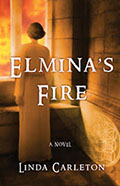Cathars and Cathar Beliefs in the Languedoc
|
|
|||||||||||||||||||
|
|
|
|
|
|
||||||||||||||
|
|
|||||||||||||||||||
|
|
|||||||||||||||||||
GENERAL READING |
|||||||||||||||||||
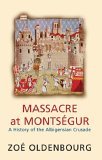 |
Massacre at Montsegur: a history of the Albigensian Crusade
Zoé Oldenburg Highly recommended. Not specifically about Montsegur but rather about the history of the Cathars in the Languedoc. Excellent introductory text. The Original version is in French, but the English version is well translated so you'd never guess. Zoe Oldenburg was originally a novelist, but this is a sound work of nonfiction (and built her an instant reputation as an historian).
|
||||||||||||||||||
 |
The Perfect Heresy: The Revolutionary Life and Death of the Medieval Cathars
Stephen O'Shea Walker & Co; (2001) This account of tale of the Cathars of the Languedoc and their destruction is sympathetic, evocative and sometimes witty. Catharism is presented as "a pacifist brand of Christianity embracing tolerance and poverty". Rejecting the authority of the Church, and claiming a series of contrary beliefs, it was considered "perfect heresy" ie complete and utter heresy. Nobles, monks, popes and kings star in this story of the "abattoir Christianity" of conflict encompassing religious and secular motivation over decades. The book's recreations of of siege warfare are particularly good. Operational methods of the Inquisition are clearly explained. This is an accessible text for non-specialists, but it is sound
history, drawing on modern scholarship and providing good notes. Stephen O'Shea is a Canadian historian, who was inspired to write this book after traveling in France. Paperback: 352 pages ; Dimensions (in inches): 1.03 x 7.91 x 5.57 Publisher: Walker & Co; (August 2001; ISBN: 0802776175
|
|
|||||||||||||||||
 |
Montaillou: village Occitan, 1294-1324
|
|
|||||||||||||||||
 |
The Albigensian Crusade
Jonathan Sumption Faber, London, 1978) Excellent history, and a brave attempt at making the case for the behaviour of the Roman Church. This book by the well know historian and English barrister (now a Supreme court judge) takes a much more informed view of the international politics of the period than most other works available. One of the many unforeseen consequences of the Cathar Wars and other actions by Pope Innocent III was the beginning of the creation of European nation states - and consequently the shape of modern Europe.
|
|
|||||||||||||||||
 |
The Yellow Cross: The Story of the Last Cathars, 1290-1329
René Weis A century or so after the start of the first Cathar wars there was a short lived resurgence of the Cathar faith in the areas around Foix. (Another aspect of this resurgence is related in Montaillou - see above). Weis's book is about this resurgence. The yellow cross of the title is a reference to to the yellow crosses that Cathars were obliged to wear by the Inquisition as a mark of public penance - similar to the yellow badges that Jews were obliged to wear as a mark of infamy, and a contrast to the red crosses worn by heroic crusaders. One of the saddest and most moving parts of the story is that concerning a man called Belibaste, the last known parfait in the area. Having led a colourful life, and having failed to live up to the high standards expected of a parfait, he nevertheless opted to die a most appalling death at the hands of the Roman Catholic Church rather than recant his faith, and spent his last days on earth trying to reconvert the erstwhile friend who had betrayed him to the Inquisition.
|
||||||||||||||||||
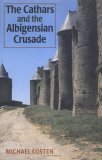 |
The Cathars and the Albigensian Crusade
Michael Costen A good all round work on the subject, though some reviewers have criticised it for an alleged pro-Catholic bias in its presentation and selection of sources.
|
|
|||||||||||||||||
 |
Chasing the Heretics:
|
|
|||||||||||||||||
INTERMEDIATE READING |
|||||||||||||||||||
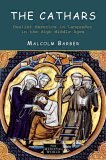 |
The Cathars in The Languedoc
Malcolm Barber An excellent book, but probably for academics and those who already know something about the Cathars. Covers the area well, with interesting information on Catharism in Italy, the larger religious context, and modern Catharism. It traces the origins and spread of Dualist ideas, assesses their attraction, and describes the reaction of the ecclesiastical and lay authorities in the form of preaching campaigns, crusades, and Inquisitorial investigations. A fascinating account of the development of religious belief and attempts to suppress it, touching on the nature of evil, the ethics of warfare, and the use made of history by later generations. The book will appeal to those interested in medieval perceptions of the world, the Crusades and the Inquisition. Malcolm Barber is Professor of History at the University of Reading.
He is the author of two books on the Templars, The Trial of the
Templars (1978) and The New Knighthood (1994) (Both also
highly recommended).
Paperback: 256 pages ; Dimensions (in inches): 0.75 x 9.00 x 6.75
;
|
|
|||||||||||||||||
 |
The Cathars (The Peoples of Europe series)
Malcolm Lambert. Blackwell Publishers, 1998. Another excellent text which traces the origins and spread of Dualist ideas, assesses their attraction, and describes the reaction of the ecclesiastical and lay authorities in the form of preaching campaigns, intellectual refutation, crusade, and Inquisitorial investigations. Though richly illustrated, this is for the enthusiast rather than the general reader. The author takes a chronological and regional approach (covering doctrinal material as the need arises). He covers heresy in Western Europe before the eleventh century and the Bogomils and early appearances of Catharism in the Rhineland. He goes on to the rise of Catharism in the Languedoc and the Roman Catholic Church's response to it (Innocent III, the crusade, and the Inquisition). The book extends to the revival of Catharism around the beginning of the fourteenth century, and also deals with Italian Catharism, and the fate of the parent Bosnian Church. Lambert notes that in Italy, unlike the Languedoc, conflicts over doctrine split Cathars into separate camps, and their survival for so long was largely attributable to the unwillingness of independent city-states to grant church authorities the powers needed to exterminate what the Roman Church saw as heresy. Malcolm Lambert was a Reader in Medieval History at the University of Bristol in the U.K. He retired in 1991 but continues to write excellent history. Paperback: 368 pages ; Dimensions (in inches): 0.75 x 9.02 x 6.03 Publisher: Blackwell Publishers; (June 1998); ISBN: 063120959X
|
|
|||||||||||||||||

|
Kill Them All!
James McDonald. ACHS, 2021 (second edition) A book by the webmaster which assesses the question of whether a Cistercian Abbot gave the famous command at the siege of Beziers in 1209 "Kill them all! God will know his own". For well over six hundred years the claim that the Abbot, Arnaud Amaury, spoke these words - a claim made by a sympathetic contemporary clerical writer - was accepted as fact. Historians over the last hundred years have been more sceptical, often describing the story of the command as "apocryphal". Almost no original work on the question had been carried out by modern historians in the English-speaking world until the publication of this book. McDonald has written a monograph that provides a thoroughgoing reassessment of the question. It presents new evidence, exposes the previously unrecognised significance of existing evidence, and frames new arguments that should shift received opinion among historians. It also ranges over many aspects of mediaeval life, belief, warfare and crusading. McDonald is a medieval historian specialising in the Cathars of the Languedoc, and the crusades against them in the thirteenth century. He writes on a range of topics including Gnostic Dualism, Occitania, the Counts of Toulouse, medieval warfare, medieval inquisitions and the Early Christian Church. His work is characterised by serious scholarship combined with an entertaining style. Paperback: 200 pages, also available as an ebook onKindle.
|
||||||||||||||||||
Medieval Heresy - Popular Movements from Bogomils to Hus
Lambert, Malcolm; (Edward Arnold, London, 1977) REVIEW TO FOLLOW
|
|||||||||||||||||||
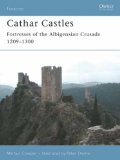 |
Cathar Castles,
|
||||||||||||||||||
 |
Power and Purity: Cathar Heresy in Medieval Italy
Carol Lansing Catharism was popular throughout Occitania, including areas that we now regard as part of Italy as well as those we now regard as parts of France. This book explores the place of Cathar heresy in the life of the medieval Italian town of Orvieto, as well as Florence and Bologna. Based on archival research, it details the social makeup of the Cathar community and argues that the heresy was central to social and political changes of the 13th century. According to this book, the late 13th Century repression of Catharism by a local inquisition was part of a redefinition of civic and ecclesiastical authority. Power and Purity will appeal to historians of society and politics as well as religion and even "gender studies". Carol Lansing is Professor of History at the University of California, Santa Barbara.
|
|
|||||||||||||||||
ACADEMIC READING |
|||||||||||||||||||
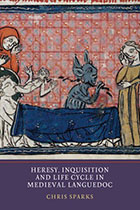 |
Heresy, Inquisition and Life Cycle in Medieval Languedoc
Chris Sparks
REVIEW TO FOLLOW
|
|
|||||||||||||||||
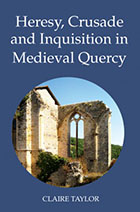 |
Heresy, Crusade and Inquisition in Medieval Quercy
Claire Taylor
REVIEW TO FOLLOW
|
|
|||||||||||||||||
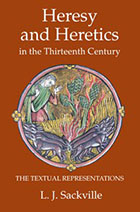 |
Heresy and Heretics in the Thirteenth Century
L.J. Sackville
REVIEW TO FOLLOW
|
|
|||||||||||||||||
 |
Voltaire on the Cathars.
|
||||||||||||||||||
 |
Bones of Contention
|
||||||||||||||||||
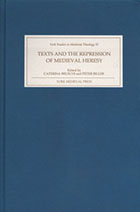 |
Texts and the Repression of Medieval Heresy
|
||||||||||||||||||
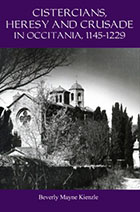 |
Cistercians, Heresy and Crusade in Occitania, 1145-1229,Preaching in the Lord's Vineyard.
Beverly Mayne Kienzle York Medieval Press, 2001
This book deals with the role of the Cistercians over 85 years, spanning the twelfth and thirteenth centuries, during which their role changed significantly, following Bernard of Clairvaux in switching the order's focus from isolated meditation and prayer, to crusading and warfare. Their new role was that of leading the Catholic Church in its persecution of dissenters and "heretics", in particular of the Cathars.
|
||||||||||||||||||
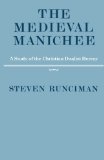 |
The Medieval Manichee,
|
|
|||||||||||||||||
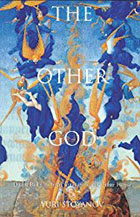 |
The Other God:
|
|
|||||||||||||||||
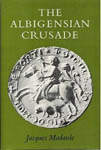 |
The Albigensian Crusade: An Historical Essay
Jacques Madaule (Translated into English by Barbara Wall)
Hardcover: 177 pages
REVIEW TO FOLLOW
|
||||||||||||||||||
|
|
Society and Government at Toulouse in the Age of the Cathars
J H Mundy This monograph continues earlier explorations of the social, economic, political and religious history of Toulouse in the earliest period for which the archives house adequate documentary materials. A second and more interesting intention is to show that there was more to the spread of Catharism than can be attributed to the intellectual or moral weaknesses of the Catholic communion or to the theological or mental attractiveness of Catharism and other dissident cults or religions. The present book and several previous ones (two published by the Pontifical Institute) have noted that religious divergence expanded and flourished when the town's well-to-do were building a semi-popular oligarchy at the expense of local princely power, a movement reaching its apogee shortly before the end of the Albigensian Crusade in 1229.. 528 p., 175 x 260 mm, 1998 Pontifical Institute of Medieval studies, Toronto, 1997
REVIEW TO FOLLOW
|
||||||||||||||||||
|
|
The Repression of Catharism at Toulouse:
|
||||||||||||||||||
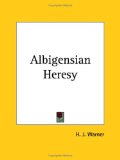 |
Albigensian Heresy (2 vols)
H J Warner In vol. I the Sources of the Albigensian Heresy are traced, and its tenets and system described. In vol. II an account is given of its suppression by Crusade and Inquisition, the former an adaptation of military measures originally taken against enemies outside the Church; the latter, a development of legal measures against enemies within the State. H J Warner is, or rather was, The Rev H J Warner and his theological training - presumably Anglican - shows. This is a book for academics, full of detail and citing sources, often in Latin. Unfortunately it is not always clear when his text refers to Cathars and when to Waldensians as he discusses both flavours of "heresy" in detail despite the title of the book. Some of the terminology is also a little difficult, largely because of changing conventions - for example Peter Des Vaux de Cernay has his name rendered as Peter de Vaux-Sarnai. The first volume was published in 1922 by MacMillan - reprinted with revisions by The Book Tree in 2007. Paperback: 332 pages
|
|
|||||||||||||||||
SOURCE DOCUMENTS IN TRANSLATION |
|||||||||||||||||||
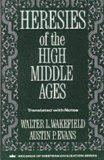 |
Heresies of the High Middle Ages
Walter L Wakefield and Austin P Evans (Translators & annotates) Columbia University Press, New York, 1969 More than seventy documents, ranging in date from the early eleventh century to the early fourteenth century and representing both orthodox and heretical viewpoints are included. This has not only reports of the heresy hunters on various 'heresies' of the middle ages. It includes what remains of the literature of the Cathars: the version of the Ascension of Isaiah, the Secret Supper of John which they had from the Bogomils, the Lord's Prayer and rites of consolamentum, and the entire Book of the Two Principles a theological defense of radical dualism.
|
|
|||||||||||||||||
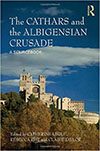 |
The Cathars and the Albigensian Crusade: A Sourcebook
Catherine Lèglu, Rebecca Rist and Claire Taylor, (Editors) Routledge, Taylor & Francis Group: London & New York, 2014. 2016 Aimed at students and scholars alike, the documents it discusses – papal letters, troubadour songs, contemporary chronicles in Latin and the vernacular, and Inquisitorial documents – reflect a deeper perception of medieval heresy and the social, political and religious implications of crusading than has previously been attempted. The reader is introduced to themes which are crucial to our understanding of the medieval world: ideologies of crusading and holy war, the complex nature of Catharism, the Church’s implementation of strategies to counter heresy, the growth of papal inquisition, southern French counter-strategies of resistance and rebellion, and the uses of Latin and the vernacular to express regional and cultural identity. This timely and highly original collection not only brings together previously unexplored and in some cases unedited material, but provides a nuanced and multi-layered view of the religious, social and political dimensions of one of the most infamous conflicts of the High Middle Ages. This book is a valuable resource for all students, teachers and researchers of medieval history and the crusades.
|
|
|||||||||||||||||
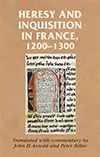 |
Heresy and Inquisition in France 1200 - 1300
John H Arnold & Peter Biller, (Translators & annotators) Manchester University Press, 2016 Heresy and inquisition in France, 1200-1300 is an invaluable collection of primary sources in translation, aimed at students and academics alike. It covers some 70 documents, selected so as not to duplicate the previous two books reviewed (except where this a good reason to do so). It covers a wide range of documentation and is divided into eight sections, each devoted to a different genre of source material: "Heretical" texts, extracts from Church chroniclers, Catholic treatises, sermons, letters, papal bulls, council records and canons, legal consultations and Inquisitors' manuals, and inquisition registers. Each source is introduced and explained, and the translated texts are accompanied by references to modern commentaries. All in all, an invaluable resource for serious students of Catharism, including contemporary debates concerning the subject. Paperback, 508 pages + good index.
|
|
|||||||||||||||||
|
|
|||||||||||||||||||
 |
The Song of the Cathar Wars. |
||||||||||||||||||
 |
The History of the Albigensian Crusade / Histoire Albigeoise Peter Des Vaux de Cernay (English translation by W.A. & M.D. Sibly) (The Boydell Press, 2000. Pbk. ISBN: 0851158072.) This is a contemporary account of the Cathar wars, written by a cleric sympathetic to the crusader cause. It is interesting as much as anything as a demonstration of how badly twisted the religious mind can become by unthinking adherence to the misconceptions that motivate it. There are several French translations, but this is the first English one. The English translators' extensive footnotes convert this work from a piece of medieval bigotry into a superb historical resource.
|
||||||||||||||||||
 |
The Chronicle of William of Puylaurens
William of Puylaurens (English translation by WA Sibly and MD Sibly) William of Puylaurens' Chronicle, here translated into English for the first time, is one of the main contemporary accounts of the Cathar Crusade. It describes heresy in the Languedoc in the early 13th century; provides a narrative of the Crusade; and outlines the growth of the Inquisition and the attack on Catharism which followed, including the siege of the Cathar castle of Montségur in 1243-44. This translation is accompanied by an introduction, full notes, appendices, and a bibliography. WA SIBLY is a former Domus Exhibitioner in Classics at Balliol College, Oxford; MD SIBLY read history at Corpus Christi College, Cambridge.
|
||||||||||||||||||
REVISIONIST HISTORY |
|||||||||||||||||||
|
Books about the revisionist theory that Cathars never really existed, until they were created by Catholic Inquisitors.
|
|||||||||||||||||||
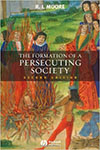 |
The Formation of a Persecuting Society:
|
||||||||||||||||||
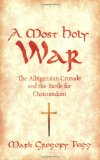 |
A Most Holy War
Mark Gregory Pegg ISBN978-0-19-539310-1 This book is probably best suited to readers who have already read at least a few books on the Cathars. The style can be just a little florid for an academic history - it is not always clear what the author means to say. Indeed after several readings I was still not certain about the central premise of the book. The blurb on the back suggests that the Cathars never really existed, and there are hints in the text that the whole Cathar "heresy" was conjured out of nothing by the Catholic Church. (From later academic papers, it is clear that this is indeed Pegg's thesis). It would have been good to have had a clear formulation of the author's thesis - along with a clear exposition of the evidence to support it. Scattered through the book are occasional attempts to discredit sources that apparently undermine the central thesis, but there is no structured argument and no explanation of how other apparently contradictory facts can be squared with the thesis. For example how could western Cathar beliefs and practices so closely match those of Bogomils and other eastern Gnostic Dualists if there was no connection, and when Catholic writers knew little about them. The style is generally very readable, but there are a few weaknesses. Extensive asides about military logistics could be interesting but come across as intrusive. One of the phrases of the chronicler Peter Des Vaux-de-Cernay is cited over and over again (the Crusaders "walking like Him [Christ]). It is a striking phrase and could be used to good effect a few times, but not dozens of times. Another of Peter's phrases "God's athlete" referring to Simon de Montfort is used once or twice without explanation. Other equally striking phrases are not mentioned at all. For example, Peter Des Vaux-de-Cernay is forever talking about the Crusaders' murderous activities as "God's Business", but Pegg does not mention that phrase. Similarly, he goes into great detail about the Occitan concept of cortezia, but mentions only in passing the far more important concept of paratge. Still, these are minor complaints. This book is well worth reading. Highly recommended.
|
|
|||||||||||||||||
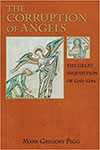 |
The Corruption of Angels: The Great Inquisition of 1245-1246
Mark Gregory Pegg, Princeton: Princeton University Press, 2001. Over two hundred and one days between May 1, 1245, and August 1, 1246, more than five thousand people from the Lauragais were questioned in Toulouse about the heresy of the good men and the good women (more commonly known as Cathars). Nobles and diviners, butchers and monks, concubines and physicians, blacksmiths and pregnant girls - all men (males over fourteen) and women (females over twelve) - were summoned by Dominican Inquisitors Bernart de Caux and Jean de Saint-Pierre. In the cloister of the Abbey of Saint-Sernin next to the basilica which still stands, they confessed before scribes and witnesses whether they had ever seen, heard, helped, or sought salvation from the heretics. This inquisition into "heretical depravity" was the single largest investigation, in the shortest time, in the entire European Middle Ages. Mark Pegg examines the sole surviving manuscript of this great inquisition with unprecedented care to build a richly textured understanding of social life in the Languedoc in the early thirteenth century. He explores what the interrogations reveal about the individual and communal lives of those interrogated and how the interrogations themselves shaped villagers' perceptions of those lives. The Corruption of Angels is a major contribution to the field. It shows how heretical and orthodox beliefs flourished side by side and, more broadly, what life was like in one particular time and place. The writing is good, but Pegg has a definite agenda.
|
|
|||||||||||||||||
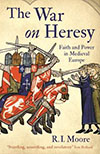 |
The War on Heresy Faith and Power in Medieval Europe
Robert I.Moore, London: Profile Books, 2012.
The war on heresy obsessed medieval Europe in the centuries after the first millennium. R. I. Moore's vivid narrative focuses on the motives and anxieties of those who declared and conducted the war: what were the beliefs and practices they saw as heretical? How might such beliefs have arisen? And why were they such a threat? In western Europe by AD 1000 heresy had barely been heard of. Yet within a few generations accusations had become commonplace and institutions were being set up to identify and suppress beliefs and practices seen as departures from true religion. Popular accounts of events, most notably of the Albigensian Crusade led by Europe against itself, have assumed the threats posed by the heretical movements were only too real. Some scholars by contrast have tried to show that reports of heresy were exaggerated or even fabricated: but if they are correct why was the war on heresy launched at all? And why was it conducted with such pitiless ferocity? To find the answers to these and other questions Bob Moore returns to the evidence of the time. His investigation forms the basis for an account as profound as it is startlingly original.
|
|
|||||||||||||||||
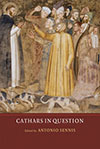 |
Cathars in Question
|
|
|||||||||||||||||
FRENCH BOOKS |
|||||||||||||||||||
L'Epopee CatharesRoquebert, Michel; (Privat, Toulouse, 1971-1994) 5 vols.
REVIEW TO FOLLOW
|
|||||||||||||||||||
La Vrai Visage du CatharismeBrenon, Anne; (Loubatieres, Toulouse, 1991)
REVIEW TO FOLLOW |
|||||||||||||||||||
Les Femmes CatharesBrenon, Anne; (Perrin, Paris, 1994)
REVIEW TO FOLLOW |
|||||||||||||||||||
Le Catharisme: la Religion Des Cathares
Duvernoy, Jean; (Privat, Toulouse, 1976) 2 vols.
REVIEW TO FOLLOW
|
|||||||||||||||||||
Registres d'inquisition de Jacques Fournier;
Duvernoy, Jean, ed. annotated translation into French of the Jacques Fournier's Inquisition records from Pamiers, 1318-1325 (Mouton, Paris,1978) 3 vols.
REVIEW TO FOLLOW |
|||||||||||||||||||
 |
Histoire Des CatharesMichel Roquebert & Catherine Bibolleet
Mass Market Paperback: 544 pages
REVIEW TO FOLLOW
|
||||||||||||||||||
CatharesYves Rouquette (Loubatieres, Toulouse, English edition, 1992)
REVIEW TO FOLLOW
|
|||||||||||||||||||
 |
Montségur, Les cendres de la libertéMichel Roquebert
REVIEW TO FOLLOW
|
||||||||||||||||||
La Vie Quotidenne Des Cathares du Languedoc au XIII siecle
Nelli, Rene; (Paris, 1969) REVIEW TO FOLLOW
|
|||||||||||||||||||
Ecritures Cathares: textes preCathares et Cathares
Nelli, Rene; (Paris, 1968) REVIEW TO FOLLOW
|
|||||||||||||||||||
La Chanson de la Croisade Albigeois,
Martin-Chabot, trans., ed.; translation from the 13th century account in the original Occitan, one of the few remaining contemporary records (Belles Lettres, Paris 1976) 3 vols.
REVIEW TO FOLLOW
|
|||||||||||||||||||
Histoire Des Albigeois
Peyrat, Nicholas; (Paris, 1870-2) 3 vols.
REVIEW TO FOLLOW
|
|||||||||||||||||||
Light and Shade in the Country of the Cathars
Roquebert, Michel & Bibolleet, Catherine; (Privat, Toulouse, 1992)
REVIEW TO FOLLOW
|
|||||||||||||||||||
Rituel Cathare: texte critique, traduction et notes
Thouzellier, C.; (Paris, 1977)
REVIEW TO FOLLOW
|
|||||||||||||||||||
NOVELS and OTHER |
|||||||||||||||||||
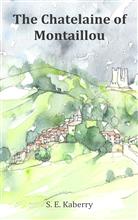 |
The Chatelaine of Montaillou
|
||||||||||||||||||
Elmina's Fire: |
|||||||||||||||||||
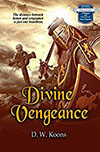 |
Divine Vengeance
D.W.Koons . This novel covers the initial phase of the Albigensian Crusade, directed against the territories of Raymond-Roger Trencavel. The crusade provides the background for an evolving love triangle, the fictitious main characters featuring in real events and interacting with real historical characters. Simon de Montfort is particularly well drawn, though his military abilities are perhaps underestimated. The book is well researched, with lots of historical detail - you can still visit many of the sites mentioned - Béziers, Carcassonne, Prouille, Bram, Lastours, Minerve, Lavaur, Toulouse - and see specific places mentioned in the novel such as the well at Minerve. Some of the events are concertinaed, presumably to help move the plot along. So for example several sieges of Toulouse become a single siege, timed as the first, but featuring events of the third. There are also a few errors. Cathar perfects were not priests. Nor were they "credentes". The military leader of the crusade until after the fall of Carcassonne was not Simon de Montfort, but Arnaud Amaury (or Almaric). He is presented as a bishop, though he was at this time an abbot (and the head of the Cistercian order). The author also seems confused about the feudal system and appears not to have understood the connection between counts and their counties, which grates in a few places. On the other hand most of these errors are likely to be noticed only by history buffs. The main theme - the destruction of a whole culture by the Church - comes over clearly, as do some of the complexities of the conflict. The title of the book, incidentally, is taken from the words of Almaric's letter to Pope Innocent III describing the events at Béziers in 1209 as "divine vengeance". Overall, a good read.
Published 2016 Bygone Era Books Ltd Denver, CO, USA
|
|
|||||||||||||||||
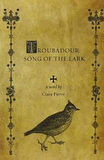 |
Troubadour, Song of the Lark, and
|
||||||||||||||||||
 |
Montsegur and the Mystery of the CatharsJean Markale This book purports to show that Catharism is not simply a heretical Christian cult as it is often portrayed, and examines evidence for the existence of a lost Cathar treasure and its possible connection to the Holy Grail. Four Cathar Perfects carried a "treasure" out of Montsegur the night before its fall, a fact that led rebel Huguenots of the 17th century and members of Hitler's S.S. to believe that an enormous treasure or some weapon of awesome spiritual power lay hidden somewhere near the ruins of the former Cathar stronghold. Unfortunately we have no idea what the Cathar "treasure" was. It might have been a small amount of money, or even a book. In other words, this is a book for conspiracy theorists. Paperback: 312 pages
|
|
|||||||||||||||||
 |
Dans l'ombre Des Cathares (Broché)Claudie Duhamel Amado & Emmanuel Amado
Cathar novel in French
REVIEW TO FOLLOW
|
||||||||||||||||||
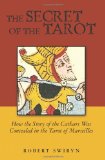 |
The Secret of the Tarot - How the Story of the Cathars Was Concealed in the Tarot of Marseilles
Robert Swiryn This book presents a case that the familiar Tarot cards associated with Marseilles contains numerous references to Catharism in the Languedoc and to historical figures involved in the Cathar Crusades. The book is well researched and contains much useful information about the Cathars and about the Tarot. Evidence of a connection between the Tarot and Catharism is largely circumstantial. Whether or not the author evinces enough evidence to clinch the case for such a linkage is a matter of opinion - you will need to read the book to decide for yourself. Either way, it is still a good read. Paperback. 274 pages. Illustrated in black and white. Published November 2010. Useful bibliography. Scholarly footnotes. Concise index. Published by Pau Hana Publishing. ISBN 13-978-0615304380 more at www.thesecretofthetarot.com
|
|
|||||||||||||||||
 |
The Good Man's Daughter
Roger Stokes
Some of the background is drawn from actual events - for example, the siege of Montsegur in 1244 and the arrests at Montaillou around 1309. There are a few questionable historical details, Albi was not at this time the seat of an archbishop; the locals would have had Occitan, not French names; Counts took their titles from counties not towns; medieval nobles did not normally eat daily breakfasts, certainly not early in the morning. But these are quibbles. The characters are perhaps a little black and white, but then the historical events and motivations were black and white. There has to be a sharp contrast between on the one hand people who opt to die an agonising death rather than renounce their pacifist faith, and on the other hand people who choose to inflict agonising deaths on hundreds of others ("with great joy" as the Catholic chroniclers put it) for the crime of disagreeing with them.
Matador Paperback, 2011 282 pages ISBN 978 1848766 662
|
|
|||||||||||||||||
MUSIC |
|||||||||||||||||||
|
|
Dominiqueby "The Singing Nun", 1963 A jolly little song, in French, that presents the traditional Catholic view of St Dominic and his role in extirpating the Cathar "heresy". There is no mention of any historical events, not even the Crusade or the Dominican Inquisition, just miraculous accounts, such as the loveable St Dominic converting an anonymous heretic, and angels delivering bread. There is a certain irony in repeated references to "the good God" - an expression that smacks of the Dualist "heresy" for which the Cathars were exterminated. Jeanne-Paule Marie "Jeannine" Deckers (1933 – 1985), known as Sœur Sourire, or The Singing Nun, was a Belgian singer-songwriter. For seven years, as a member of the Dominican Order in Belgium, she was also known as Sister Luc-Gabrielle. She acquired widespread fame in 1963 with the release of this song, which topped the US Billboard Hot 100 and other charts. The song is a highly sanitanised account of the life of the founder of the religious Order to which she belonged. Bullied by her fellow nuns because of her success, she left her Order. Her royalties had been paid to her convent but she was held personally responsible for the associated income tax, and she committed suicide under the financial pressure of Belgian tax demands. In 1966, a movie starring Debbie Reynolds called The Singing Nun about Sister Luc-Gabrielle was released. As so often, American producers took liberties, glossing, sugaring, dramatizing and distorting the story. In the film, a version of the song with English lyrics (that had no connection with the original) was used. The film bombed at the box office. There was also an undistinguished Italian film about her, Suor Sorriso. Genres: Vocal/Easy Listening, Christian/Gospel, Folk. Awards: Grammy Award for Best Inspirational Performance.
Youtube - 1963 version of Dominique by Jeanne-Paule Marie "Jeannine" Deckers ..
Youtube - 1982 disco version of Dominique by by Jeanne-Paule
Marie "Jeannine" Deckers, produced in 1982 by Marc Moulin
and Dan Lacksman of the Belgian electro band Telex. (film clip from
Felini's Roma) ..
Youtube - An Italian version by another Singing Nun, watched
by some spectacularly unimpressed children. ..
Youtube - The trailor for the Debbie Reynolds Film - demonstrating
why the film bombed so badly. ..
|
||||||||||||||||||
|
|
Montségur
Iron Maiden, 2003 This is the fourth track on the Album, Dance of Death, written by Janick Gers, Steve Harris, & Bruce Dickinson. The lyrics are credited to Bruce Dickinson. The song is losely based on the fall of the Cathar stronghold of the same name, in 1244. It is clearly well-intentioned, but does not represent reliable history (the song has the Knights Templar involved), so is likely to be of interest only to heavy metal fans. Genre: Heavy metal
Youtube .. |
||||||||||||||||||
|
|
Massacre At Beziers
Wizz Jones, 1993 From the album: Late Nights and Long Days. This song is exacly what the title says: an account of the massacre at Beziers in 1209, the first serious action in the Cathar Crusade. The lyrics artfully steers clear of anything explicit about the massacre, but demonstrate a detailed knowledge of events. The message is conveyed by allusions. And does guitar playing come any better than this? Genre: Folk
Youtube - Wizz Jones - Massacre At Beziers, Live at the Ely Folk Festival 2010 . |
||||||||||||||||||
|
|
The Cathars of the Languedoc (Album)
Allan Baldwin, 2019 Nine instrumental pieces, all composed, produced and performed by Allan Baldwin.
Genre: Pop, blues, jazz, folk A well produced album, with atmospheric instrument music, tracing the history of the Cathars and the Crusade against them. For more information, or to buy a copy, please contact mrallanbaldwin@gmail.com
|
||||||||||||||||||
|
|||||||||||||||||||
|
|

|
||||||||||||||||||
|
|
|
||||||||||||||||||
|
|
 |
||||||||||||||||||
|
|||||||||||||||||||
|
|
|
|
|
|
||||||||||||||
|
|
|||||||||||||||||||
|
|||||||||||||||||||








